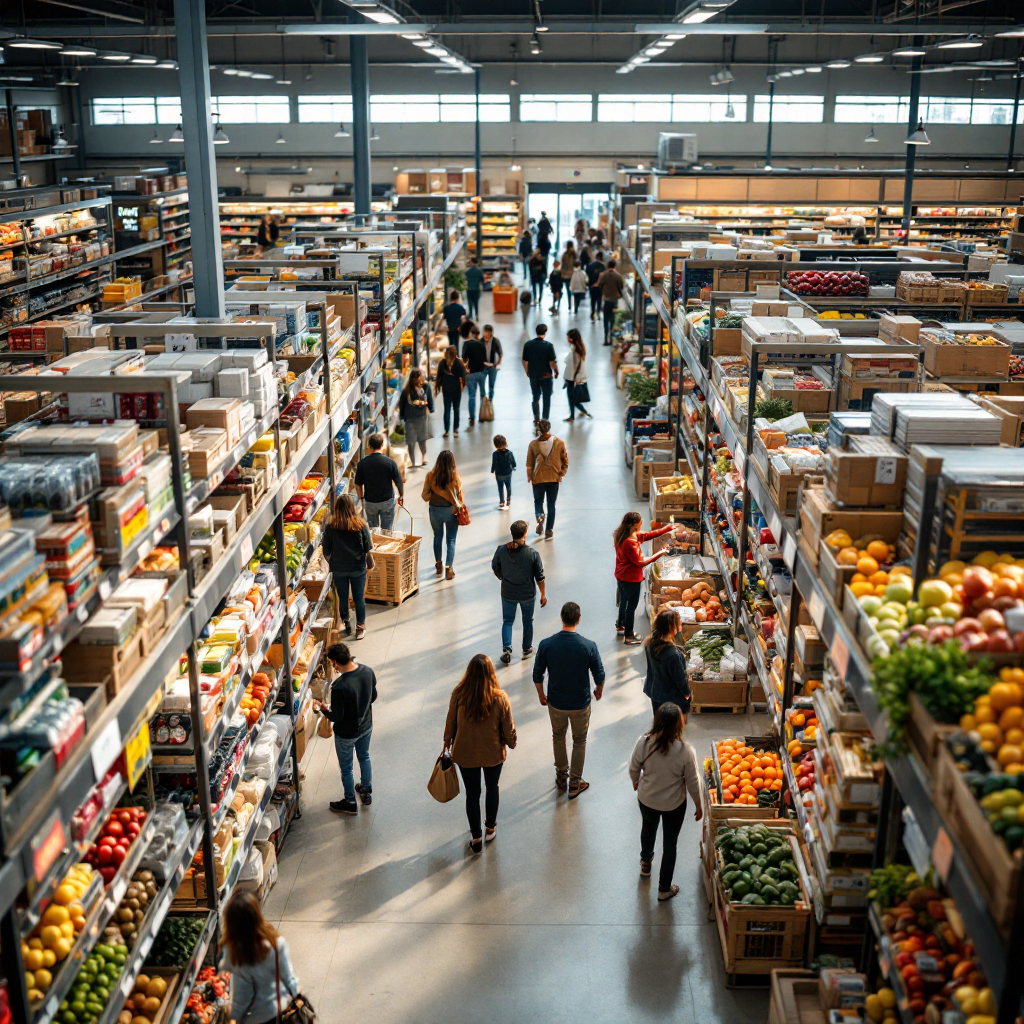people counting and analytics in retail supermarkets
People counting technology records the number of people entering and leaving a space and it reports movement inside. The technology spans overhead sensors, camera-based counts, and AI. Retailers use people counting to see how many shoppers arrive during an hour. As a result, they can allocate staff, reduce congestion, and improve the shopping experience quickly. For example, studies show that supermarkets using people counting systems can reach a 15-20% rise in operational efficiency by matching staff to real-world demand (survey data). And retailers often cite improved conversion when they use accurate counts to time promotions and shifts (industry report).
In supermarkets the emphasis lies on flow. Operators measure footfall and dwell for specific aisles and displays. They measure the number of visitors and they track people entering, moving between zones, and exiting. This flow data forms the basis for actionable insights and informed decisions about staff schedules and shelf replenishment. Visitor flow metrics help managers make informed decisions on promotions and staffing. They also enable retail teams to reduce empty checkout lanes and to schedule cleaning or restocking at low-traffic times.
People counting for retail stores goes beyond simple entrance tallies. Today’s systems merge counts with timestamps and location tags so that managers can study traffic patterns and customer behaviour in detail. Visitor analytics and people counting data can feed dashboards that show kpis such as average dwell time, conversion rates, and peak hour load. Retail chains that adopt these tools shift from calendar-based staffing to demand-based staffing. They gain operational efficiency and better customer engagement. To explore how video-based solutions work in retail, see our overview of AI video analytics for retail here.
modern people counting solution for store people management
Modern people counting solution options range from passive thermal sensors to intelligent video analytics. A smart system combines on-prem processing with flexible models, and it runs on existing CCTV. Visionplatform.ai turns cameras into a sensor network so stores can use their VMS to detect people in real time. This approach keeps data local and supports GDPR and EU AI Act needs. The platform streams structured events to dashboards and to operational tools, and it lets teams act on counts fast.
Features you should expect include accuracy over different lighting, on-edge inference, and the ability to tune models for your site. A counting solution must handle groups, strollers, and pauses near displays. modern people counting often blends depth sensors and AI to reduce false positives and to separate staff from shoppers. Also, systems should export people counting data to workforce management and to BI. That way staff can get scheduled when and where demand peaks.
Use cases are practical. A small retail outlet can deploy people counters at its single entrance. A bigger retail business can use overhead sensors across multiple aisles and stores. People counters inform where to place a pop-up stand and how many registers to open. In addition, a modern people counting system integrates with loss prevention and with queue detection tools. For more technical context on integrating AI with VMS, read about Milestone XProtect AI for retail stores here.

AI vision within minutes?
With our no-code platform you can just focus on your data, we’ll do the rest
video analytics, wi-fi tracking and foot traffic measurement
Video analytics and wi-fi combine to produce richer foot traffic metrics. Video gives counts and path tracking. Wi-fi captures device presence and repeat visits. Together they reduce blind spots and they create more accurate people counts. For instance, blending video analytics and wi-fi helps match anonymous device pings to known peak windows. This reduces double counting and improves trend analysis.
Advanced video analytics can run on the edge and it can publish structured events in real time. Intelligent video analytics detects motion, defines zones, and logs path tracking so managers can map areas of your store by popularity. This zone analytics approach yields insights into how displays perform and where dwell time spikes. When combined with wi-fi signals, the system can estimate visit frequency and visit duration. In practice, teams use that data from people counting to adjust promotions and to inform decisions about product placement.
Footfall traffic metrics then guide staff planning. Stores can forecast how many staff they need at specific hours. They can split duties and open more tills during high demand. By connecting people counting systems to scheduling tools, stores reduce long lines and improve customer satisfaction. Also, video-based metrics feed analytics platforms so teams can track kpis continuously. For a deep dive into machine vision concepts used in these setups, refer to our machine vision resource here.
Retail chains that measure foot traffic patterns see clear benefits. They can spot slow aisles and they can retarget promotions to low-traffic zones. They can also measure the effect of signage and of sample stations. If you want to analyse performance over time, merging video analytics with wi-fi yields robust visitor data and valuable insights into customer behaviour. One study confirms that participants expect smart urban and retail tech to help improve commercial spaces (survey).
heatmaps and visitor analytics to optimize store layouts and queue management
Heatmaps are a visual representation of where shoppers go and where they pause. They show hot and cold zones across shelves, endcaps, and checkouts. A heatmap can show you where customers linger and where they bypass. Using heatmaps lets retailers reconfigure aisles and displays to guide shopper flow. In one industry report retailers that use heatmap analytics can increase product placement effectiveness by up to 25% (report).
Heat map tools show dwell time and the paths shoppers take. They also highlight queue build-up before tills. With that intel retail teams can open additional lanes and they can move staff to reduce wait times. Zone analytics and path tracking help planners test layout changes quickly. They can run A/B comparisons across stores to measure conversion rates after a layout shift. Heatmaps therefore support data-driven decisions on placement and on visual merchandising.
In practice, teams overlay transaction data on heatmaps to link heat zones to sales. They identify high-traffic spots and they push high-margin items to those areas. They also identify low-traffic aisles and they try new placement to attract attention. Smart people counting and heatmap workflows deliver valuable insights into customer behaviour. They help reduce queue pressure and they make shopping more pleasant for the customer.

AI vision within minutes?
With our no-code platform you can just focus on your data, we’ll do the rest
data-driven strategies to increase sales and manage footfall
Data-driven tactics turn visitor flow into higher revenue. First, use people counting and heatmaps to pick the best locations for promotions and for product placement. Then, test small changes and measure conversion rates. Retail teams can increase sales by aligning promotional timing to high-traffic windows. They can also place impulse buys near checkouts and near high-traffic aisles to lift average basket value.
Another strategy ties staffing to demand. When you match staff levels to predicted peaks you improve customer engagement and you reduce abandoned carts. Data-driven decisions also guide inventory planning. Stores that see repeat peaks for certain SKUs can keep more stock on shelf. Also, they can redistribute inventory across stores to avoid out-of-stock events. This lowers lost sales and it supports consistent customer behaviour improvement.
Marketing efforts benefit from footfall insights. Teams can target in-store displays and coupons where they matter most. They can also time loyalty messages to moments of high dwell time. By combining visitor analytics with purchase data, you can run targeted promotions that drive conversion. The result includes better customer engagement and satisfaction and measurable increases in sales. For evidence on spatial-data impact in public spaces, see the study using participatory mapping that parallels store heatmap use (research).
implementing people counters and heat map tools to enhance shopper experience
Start implementation by assessing your existing cameras and network. Many retailers already have CCTV that they can reuse. Visionplatform.ai converts those cameras into an analytics platform so shops can run on-prem models. This approach reduces cloud dependency and it protects customer privacy. It also provides an analytics platform that streams events to BI and to operations.
Next, deploy people counters at entrances and across key zones. Then, enable heat map reporting on a schedule that matches store operations. Train staff to use dashboard alerts so they can act when queues form. Use visitor analytics to measure customer satisfaction and to refine schedules. When you track customer behaviour and store people flow, you collect data that supports informed decisions. You can then improve customer engagement and satisfaction and you can reduce bottlenecks.
Measure impact with clear KPIs. Track metrics such as number of visitors, footfall, conversion rates, and average dwell time. Review changes after layout shifts and staffing adjustments. Use experiments and compare results across locations. With continuous measurement, retailers can optimize their operations and they can optimize store layouts to improve the shopping experience. As one specialist noted, “Heatmaps provide a granular view of customer interactions with the store environment, enabling retailers to rethink layout and product placement dynamically” (expert quote). Finally, retailers can scale from a single outlet to multi-store rollouts and they can keep control of models and data for compliance.
FAQ
What is people counting and how does it work?
People counting uses sensors, cameras, or AI to count people as they enter and move through a space. Systems may run on edge devices or in the cloud and they often integrate with your VMS to provide structured event streams.
How do heatmaps help retailers?
Heatmaps visualise where shoppers spend time and where they pass quickly. Retailers use them to improve product placement and to reduce queue build-up by moving staff proactively.
Can existing CCTV be used for people counting?
Yes. Platforms like Visionplatform.ai convert existing CCTV into a sensor network so stores avoid costly new hardware. This method also supports on-prem processing for GDPR and EU AI Act readiness.
Are people counters accurate in busy stores?
Modern people counting systems use AI and multi-sensor fusion to handle groups and overlaps. Accuracy improves when you combine video analytics with wi-fi and when you tune models to the site.
What metrics should I track after deploying counters?
Track kpis such as number of visitors, dwell time, conversion rates, and peak hours. These metrics help you make informed decisions on staffing and on product placement.
How do video analytics and wi-fi complement each other?
Video analytics offers precise counts and path tracking, while wi-fi captures repeat visits and device presence. Combined, they reduce false counts and create fuller visitor data for trend analysis.
Will heatmaps reveal customer behaviour anonymously?
Yes. Heatmaps aggregate movement and they do not need personal identifiers. They focus on flow and on areas of your store rather than on individuals.
How quickly can I see ROI from these tools?
Many retailers see benefits within weeks through improved staff allocation and by optimizing high-traffic placement. Studies also show measurable gains such as higher operational efficiency when counts guide actions (reference).
Can these systems help reduce wait times?
Yes. Real-time alerts and flow analytics let staff open tills before queues escalate, thus reducing wait times and improving customer satisfaction.
What compliance considerations matter for video analytics?
Process data on-prem and keep control of models to meet GDPR and AI regulation requirements. On-device inference and local event streaming help reduce data leaving your environment and support auditability.

